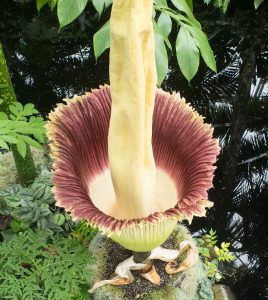The Science of Stink
Posted in Interesting Plant Stories on July 29, 2016 by Stevenson Swanson
Stevenson Swanson is the Science Media Manager at The New York Botanical Garden.
 Ah, New York in the summer. So many fetid fragrances fill the air. The garbage on the sidewalk, the hot blast of exhaust from a passing bus, the dank odor of the subway—these and even less savory sources best left to the imagination all add their odors to the city’s atmosphere on a hot, humid day.
Ah, New York in the summer. So many fetid fragrances fill the air. The garbage on the sidewalk, the hot blast of exhaust from a passing bus, the dank odor of the subway—these and even less savory sources best left to the imagination all add their odors to the city’s atmosphere on a hot, humid day.
That makes it all the more remarkable that thousands of New Yorkers have flocked to The New York Botanical Garden to see the corpse flower that is now blooming in the Enid A. Haupt Conservatory. Apart from its size and striking appearance, the plant is notable for its stench, often compared to the smell of rotting flesh, which is the clever ploy it has evolved to attract pollinators.
Perhaps the fact that the plant blooms so infrequently and unpredictably draws most people, but many seem fascinated by the phenomenon that something in nature would smell this bad on purpose.
As it turns out, scientists have devoted no small effort to identifying the complex chemistry that combines to produce the corpse flower’s distinctive aroma. That bouquet of rotting flesh? It’s dimethyl disulfide and trimethylamine. The accent of sweaty socks? That’s isovaleric acid. And the not-so-subtle hint of limburger cheese? Dimethyl trisulfide, of course.
The subject has proven so fascinating that the American Chemical Society has even produced a video about it.
All well and good, but a video can only do so much. There’s only one way to find out how much a corpse flower smells like summer in New York City—by getting a whiff of it in person.
The Haupt Conservatory will remain open from 9 a.m.–8 p.m. on Friday and Saturday, July 29 and 30, to any visitors daring enough to brave the smell. If you can’t make it in person, don’t miss the live feed of the plant running 24/7.

